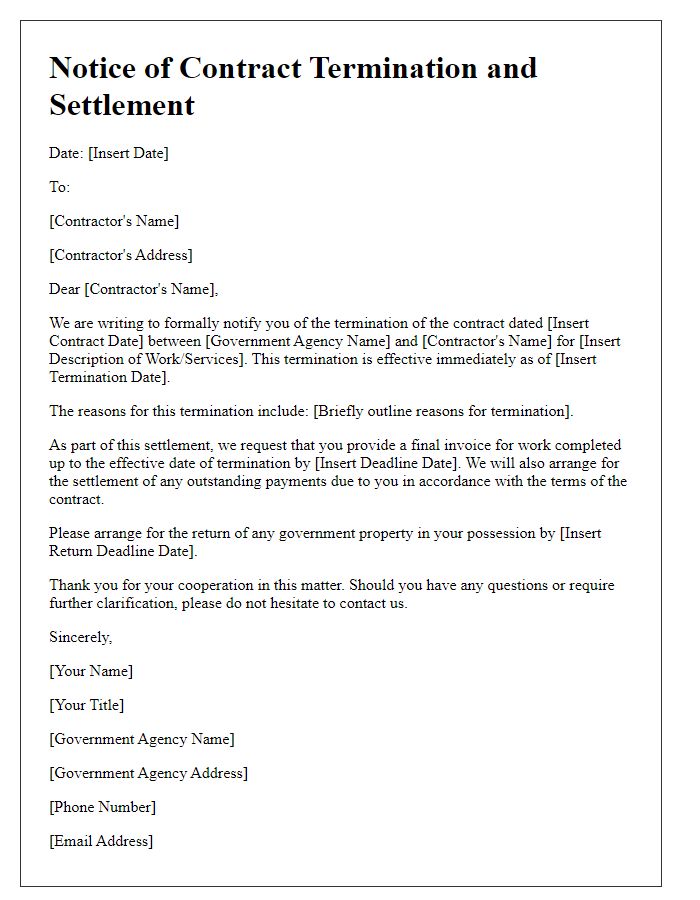Navigating the complexities of government contracts can be challenging, especially when it comes to termination. Whether you're looking to end a contract due to budget constraints, performance issues, or other unforeseen circumstances, it's essential to communicate your intentions clearly and professionally. In this article, we'll walk you through a sample letter template that outlines the necessary elements for effectively terminating a government contract. So, if you're ready to learn more about this vital process, keep reading!

Clear identification of parties involved
A government contract termination letter includes precise identification of involved parties, ensuring clarity in communication. The primary contracting agency, such as the Department of Defense or the Department of Health and Human Services, must be clearly stated, along with its corresponding address and unique contract number, often accompanied by a project title or description. The contracting party, which could be a private company or organization, should also be identified, including their full legal name, address, and relevant tax identification number. Both parties' designated representatives, typically including the names and titles of authorized officials, help facilitate the termination process, ensuring that documentation is handled appropriately and efficiently. This clear identification aids in preventing misunderstandings and ensures a smooth contractual conclusion.
Reference to specific contract and clauses
When the government decides to terminate a contract, specific references should be made to the contract number, the title of the contract, and relevant clauses within that contract that provide the basis for termination. For instance, the contract number could be "Contract No. ABC-12345" with a title like "Supply of Medical Equipment". Relevant clauses might include Clause 12: Termination for Convenience, which allows the government to terminate the contract with or without cause, and Clause 15: Default, which outlines conditions under which the government may terminate due to contractor failure to comply with contract terms. In such cases, it is important to provide clear reasoning based on these clauses, such as performance issues, failure to meet deadlines, or changes in government needs, thereby ensuring a legally sound termination process.
Detailed reason for termination
Government contracts may be terminated for various reasons, including failure to meet performance milestones, budget overruns, or non-compliance with specific regulations. One common reason involves delays in project delivery; for instance, if a contractor consistently fails to deliver materials or services by the scheduled deadlines outlined in the contract, this situation can lead to significant project lag affecting operational timelines. Another pertinent cause is financial mismanagement; if the contractor exceeds budget constraints (averaging over 20% in excess costs) without proper justification or renegotiation, this raises concerns about the responsible use of taxpayer funds. Additionally, non-compliance with terms related to labor laws, such as the Fair Labor Standards Act or requirements pertaining to Diversity and Inclusion in subcontracting practices, can also prompt termination. Such breaches not only violate established agreements but can also have legal ramifications, necessitating action to uphold contract integrity and uphold standards expected in government procurement processes.
Effective date of termination
Government contracts may face termination due to various reasons, such as performance issues or budget constraints. The effective date of termination signals the end of contractual obligations for both parties. For instance, the Federal Acquisition Regulation (FAR) outlines processes for termination for convenience or default. Such termination can impact multiple stakeholders, including government agencies like the Department of Defense (DoD) and contractors specializing in services or supplies. Clear communication of the termination date, often requiring a formal notice, ensures all involved parties can adjust plans accordingly, safeguarding taxpayer interests while maintaining accountability.
Instructions for any remaining obligations or actions required
The termination of a government contract signifies the end of a formal agreement under which services or goods were to be provided, as outlined in the Federal Acquisition Regulation (FAR) guidelines. Following termination, it is crucial to address remaining obligations, such as submitting final invoices within 30 days, returning government property, and completing any outstanding deliverables defined in the contract. The contractor must provide a comprehensive report detailing the status of work performed and any pertinent documentation. Additionally, any payments for work completed prior to termination may require resolution in accordance with Section 49.109 of the FAR. All actions should comply with local jurisdiction regulations and be submitted to the contracting officer at the designated government agency (e.g., General Services Administration or Department of Defense).













Comments